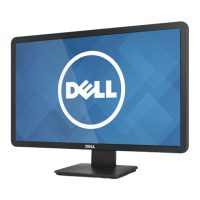
Do you have a question about the Dell E2014T and is the answer not in the manual?
| Pixel pitch | 0.27 x 0.27 mm |
|---|---|
| Aspect ratio | 16:9 |
| Screen shape | Flat |
| Response time | 2 ms |
| Display diagonal | 19.5 \ |
| Touchscreen type | Tabletop |
| Display brightness | 225 cd/m² |
| Display resolution | 1600 x 900 pixels |
| Display technology | LED |
| Viewing angle, vertical | 160 ° |
| Contrast ratio (dynamic) | 8000000:1 |
| Contrast ratio (typical) | 1000:1 |
| Display number of colors | 16.78 million colors |
| Display diagonal (metric) | 49.4 cm |
| Viewing angle, horizontal | 170 ° |
| Certification | EPEAT Gold\\r TCO |
| Product color | Black |
| Display viewable area (HxV) | 432.00 x 432.00 mm |
| Dimensions (W x D x H) with stand | 505.9 x 165 x 376 mm |
| Cables included | AC, HDMI, USB |
| Tilt angle range | 5 - 31 ° |
| AC input voltage | 100 - 240 V |
| AC input frequency | 50 - 60 Hz |
| Power consumption (standby) | 0.5 W |
| Power consumption (typical) | 16 W |
| USB upstream port type | USB Type-B |
| USB Type-A downstream ports quantity | 2 |
| Package weight | 6070 g |
| Sustainability certificates | ENERGY STAR |
| NVIDIA G-SYNC | No |
| Depth (with stand) | 165 mm |
|---|---|
| Width (with stand) | 505.9 mm |
| Height (with stand) | 376 mm |
| Weight (with stand) | 4890 g |
| Depth (without stand) | 51.7 mm |
| Height (without stand) | 311.2 mm |
| Weight (without stand) | 3430 g |
Lists the components included with the monitor.
Details the key specifications and capabilities of the monitor.
Identifies and describes physical buttons and ports on the front and side of the monitor.
Identifies and describes physical buttons and ports on the back and bottom of the monitor.
Lists technical details regarding the monitor's display panel.
Provides specifications for touch functionality, resolution, and electrical requirements.
Covers environmental conditions, display modes, and physical attributes.
Details USB/Audio ports, dimensions, weight, and power management modes.
Details the pin configurations for VGA and HDMI connectors.
Details the pin configurations for DisplayPort and USB connectors.
Covers setup, pixel policy, and guidelines for cleaning and handling the monitor.
Instructions for stand attachment and connecting display and USB cables.
Detailed instructions for connecting VGA, DisplayPort, and HDMI cables.
Guides on organizing cables and safely removing the monitor stand.
Steps for mounting the monitor on a wall using a VESA-compatible bracket.
Describes the function of buttons located on the side panel of the monitor.
Details the usage of the front-panel buttons for making adjustments.
Explains how to open and navigate through the monitor's OSD menu.
Covers OSD settings for energy consumption and display brightness/contrast.
Details OSD functions for automatic display adjustment and input source selection.
Explains color settings, input formats, and preset display modes within the OSD.
Describes image enhancement and hue adjustment settings available in the OSD.
Covers saturation, reset options, and detailed display configuration within the OSD.
Details energy settings, power button LED, and USB configuration within the OSD.
Explains OSD language, transparency, timer, lock, and reset menu settings.
Covers DDC/CI, LCD conditioning, and other miscellaneous OSD settings.
Describes personalization of shortcut keys and factory reset options in the OSD.
Explains common warning messages displayed by the monitor for troubleshooting.
Guides on how to set the monitor's maximum display resolution in Windows.
Explains monitor tilt adjustment and how to use the self-test feature.
Details how to use the monitor's built-in diagnostic tool for troubleshooting.
Lists common issues and their potential solutions for monitor display problems.
Continues troubleshooting common display, synchronization, and color issues.
Addresses color issues, image retention, and safety-related problems.
Provides solutions for touch input errors, alignment issues, and non-responsiveness.
Addresses problems related to screen image size and front panel control responsiveness.
Troubleshoots issues with USB ports and high-speed data transfer functionality.
Contains safety warnings, regulatory notices, and contact details for Dell support.
Guides on setting display resolution and downloading/installing video drivers.
Instructions for connecting and configuring multiple monitors using keyboard shortcuts.
Steps for configuring display settings for multiple monitors in Windows Vista.
Steps for configuring display settings for multiple monitors in Windows 7.
Steps for configuring display settings for multiple monitors in Windows 8.
Further configuration steps for multiple displays in Windows 8.
Options for duplicating or extending displays across multiple monitors.
Details on how to extend the desktop across multiple monitors.
Guidance on selecting which monitor displays content when using multiple displays.
Specific configurations for Windows 7 multiple display setups.
Specific configurations for Windows 8 multiple display setups.